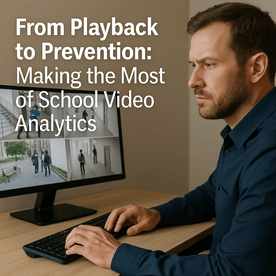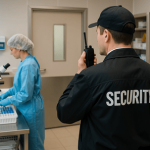
Video cameras used to be the “silent witnesses” of school incidents—there to watch, record, and provide evidence after something happened. But what if your cameras could act before the situation escalates?
With today’s advances in video analytics, schools are no longer limited to just playback. Instead, campuses can use smart cameras and artificial intelligence to prevent problems, not just respond to them.
In this post, we explore how K–12 schools can use video analytics to enhance prevention, improve safety outcomes, and support a more proactive security posture.
k
k
🎥 What Is Video Analytics?
Video analytics refers to software that automatically analyzes video footage in real-time (or post-event) to identify and flag:
-
Unusual behaviors
-
Defined objects or people
-
Movement patterns
-
Violations (like trespassing or loitering)
Modern analytics are powered by AI and machine learning, which means they improve over time, becoming more accurate and more relevant to your specific campus needs.
k
k
🔄 Playback-Only vs. Prevention-First
Let’s compare the traditional approach with a more modern, analytics-driven one:
| Approach | Playback-Only Surveillance | Prevention-Focused Analytics |
|---|---|---|
| Function | Records video for post-incident review | Analyzes footage in real time |
| Response Time | Reactive (after the fact) | Proactive (alerts during incidents) |
| Staff Involvement | Manual footage review | Automated alerting and tagging |
| Effectiveness | Useful for evidence gathering | Useful for preventing escalation |
🎯 “The shift to analytics is about turning cameras into decision-making tools, not just record-keepers.”
k
k
🚨 Key Ways Video Analytics Prevent School Incidents
1. Fight Detection
Video analytics can recognize:
-
Aggressive physical motion
-
Sudden crowd surges
-
Fast body movements near lockers or stairwells
These behaviors automatically trigger alerts to school security or administration before a staff member even sees it unfold.
k
k
2. Loitering and Trespassing
Most vandalism and unauthorized access occurs after hours or in low-traffic zones.
Analytics can detect:
-
Individuals lingering too long in sensitive areas
-
People moving through doors after hours
-
Entry into staff-only or restricted locations
Instead of discovering damage the next day, schools can get real-time alerts to intervene immediately.
k
k
3. Object Detection
Advanced systems can identify:
-
Left-behind bags (potential safety hazard)
-
Students holding unauthorized items
-
Vehicles or license plates entering prohibited zones
All of this happens automatically—with the system highlighting the clip and even notifying your team.
k
k
4. Behavioral Pattern Recognition
Analytics can flag:
-
Students walking against the usual flow (e.g., entering an exit-only hallway)
-
Unusual pacing or erratic movement (which may suggest distress)
-
Repeated presence of individuals in the same area across different days
Over time, this pattern recognition can help spot emerging risks like bullying, mental health concerns, or planning behaviors.
k
k
🧠 Practical Benefits for K–12 Schools
| Benefit | Impact |
|---|---|
| Faster Response Times | Alerts before a situation escalates |
| Reduced Staff Burden | Less time manually reviewing video |
| Better Investigations | Footage is pre-tagged with context |
| Improved Deterrence | Students know risky behavior is detected |
| Supports SEL & Safety Goals | Helps identify and de-escalate non-violent incidents |
🤝 Real-World Example
A middle school in Georgia integrated video analytics into its hallway and cafeteria cameras. Within the first semester, the system:
-
Flagged 6 physical altercations in under 10 seconds
-
Alerted staff to late-night loitering near portable classrooms
-
Captured footage of vandalism before damage was done
The school used this data to adjust staff deployment, lighting, and access policies—leading to a 40% drop in incidents.
k
k
🛠️ How to Make the Most of Video Analytics in Your School
-
Start with your goals: What are you trying to prevent—fights, vandalism, intrusion? Tailor your settings.
-
Map your camera zones: Prioritize areas where visibility matters most (stairwells, parking lots, entrances).
-
Choose analytics with flexibility: Look for systems that allow custom rules and integration with your existing tech.
-
Involve your IT and safety team early: Ensure bandwidth, storage, and alert workflows are aligned.
-
Train staff on alerts—not just cameras: It’s about recognizing and acting on the signals.
k
k
🔐 Final Thoughts
Video analytics take your existing investment in surveillance and make it smarter. Instead of watching video after something happens, your school can act during—or even before—the incident occurs.
That’s the difference between surveillance and safety.
Ready to Upgrade from Playback to Prevention?
SSP helps schools implement AI-enhanced video surveillance that detects problems before they escalate.


